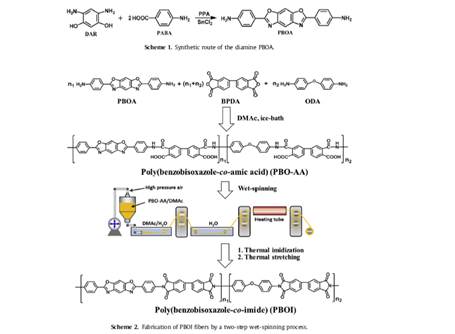Synthesis of poly(benzobisoxazole-co-imide) and fabrication of high-performance fibers. YangCheng, JieDong, CairanYang, TingtingWu, XinZhao, QinghuaZhang. Polymer, 133: 50-59.

Abstract:A novel heterocyclic and plank-shape diamine monomer, 2,6-(4,40-diaminodiphenyl) benzo[1,2-d:5,4-d'] bisoxazole(PBOA),was successfully synthesized from readily available compounds of 4,6-diaminoresorcinol dihydrochloride (DAR) and p-aminobenzoic acid (PABA). A series of poly(benzobisoxazole-co-imide) (PBOI) fibers based on 3,30,4,40-biphenyltetracarboxylic anhydride (BPDA),4,40-diaminodiphenyl ether (ODA) and PBOA were fabricated via a two-step wet-spinning method. PBOA was characterized in detail, and the effect of the monomer in the polymer backbones on the fibers' microstructure and properties were described. 2D wide-angle X-ray diffraction indicated that the incorporated PBOA in the BPDA-ODA polyimide backbone is beneficial for forming well-defined crystalline regions in the resulted fibers during the thermal stretching process and significantly improving the crystallinity and crystal orientation of the drawn PBOI fibers. Small-angle X-ray scattering patterns of the drawn PBOI fibers suggested the presence of typical periodic lamellar crystal in the fibers. It is shown that increasing PBOA contents will result in higher values of the long period (L) and the lamellar thickness (lc). Maximum improvements of 153% in tensile strength and 282% in modulus were achieved when increasing the molar content of PBOA in the mixed diamine from 10 mol% to 50 mol%. Correspondingly, the temperature at the maximum degradation rate (Td-max) and glass transition temperature (Tg) of resulted PBOI fibers in nitrogen increased by 28 and 30 ℃, respectively, making these novel polymeric fibers as good reinforcements in fabricating advanced composites.